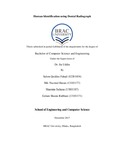| dc.contributor.advisor | Uddin, Dr. Jia | |
| dc.contributor.author | Fahad, Salem Quddus | |
| dc.contributor.author | Hasan, Md. Nazmul | |
| dc.contributor.author | Sultana, Sharmin | |
| dc.contributor.author | Rabbani, Golam Shams | |
| dc.date.accessioned | 2018-02-15T09:46:03Z | |
| dc.date.available | 2018-02-15T09:46:03Z | |
| dc.date.issued | 2017-12 | |
| dc.identifier.other | ID 12201038 | |
| dc.identifier.other | ID 13101177 | |
| dc.identifier.other | ID 13101187 | |
| dc.identifier.other | ID 13101171 | |
| dc.identifier.uri | http://hdl.handle.net/10361/9485 | |
| dc.description | This thesis report is submitted in partial fulfilment of the requirements for the degree of Bachelor of Science in Computer Science and Engineering, 2017. | en_US |
| dc.description | Cataloged from PDF version of thesis report. | |
| dc.description | Includes bibliographical references (pages 29-31). | |
| dc.description.abstract | Dental biometrics is a very important feature in human identification. It can help greatly in Forensic Dentistry. In this paper, we present a method for identifying people based on shapes and appearances of their teeth using Edge detection, pixel value counting and feature extraction. This method automatically detects important features to identify a person. Wiener filter is used to reduce noise and provide a smooth image. For edge detection, we have used Canny Edge Detection algorithm where preprocessed filtered grey scale image's edge has been defined through Gaussian filtering and Edge thresholding. From the given edge detected image canny method determines the region of shape which represents binary pixel value. This pixel value can be used in image identification. Furthermore, the SURF algorithm used to define interest points. Given a query image (i.e., Postmortem radiograph), each tooth is matched with the archived teeth in the database (Antemortem radiographs). Our goal of using appearance and shape-based features together is to overcome the drawback of using only the contour of the tooth, which can be strongly affected by the quality of the images. The experimental results are based on a database of 20 panoramic x ray images show that our method is effective in identifying individuals based on their dental radiographs. | en_US |
| dc.description.statementofresponsibility | Salem Quddus Fahad | |
| dc.description.statementofresponsibility | Md. Nazmul Hasan | |
| dc.description.statementofresponsibility | Sharmin Sultana | |
| dc.description.statementofresponsibility | Golam Shams Rabbani | |
| dc.format.extent | 31 pages | |
| dc.language.iso | en | en_US |
| dc.publisher | BRAC University | en_US |
| dc.rights | BRAC University thesis reports are protected by copyright. They may be viewed from this source for any purpose, but reproduction or distribution in any format is prohibited without written permission. | |
| dc.subject | Edge detection | en_US |
| dc.subject | Pixel value | en_US |
| dc.subject | SURF algorithm | en_US |
| dc.subject | Feature extraction | en_US |
| dc.subject | Dental radiograph | en_US |
| dc.subject | Human identification | en_US |
| dc.subject | Dental biometrics | en_US |
| dc.title | Human identification using dental radiograph | en_US |
| dc.type | Thesis | en_US |
| dc.contributor.department | Department of Computer Science and Engineering, BRAC University | |
| dc.description.degree | B. Computer Science and Engineering | |

